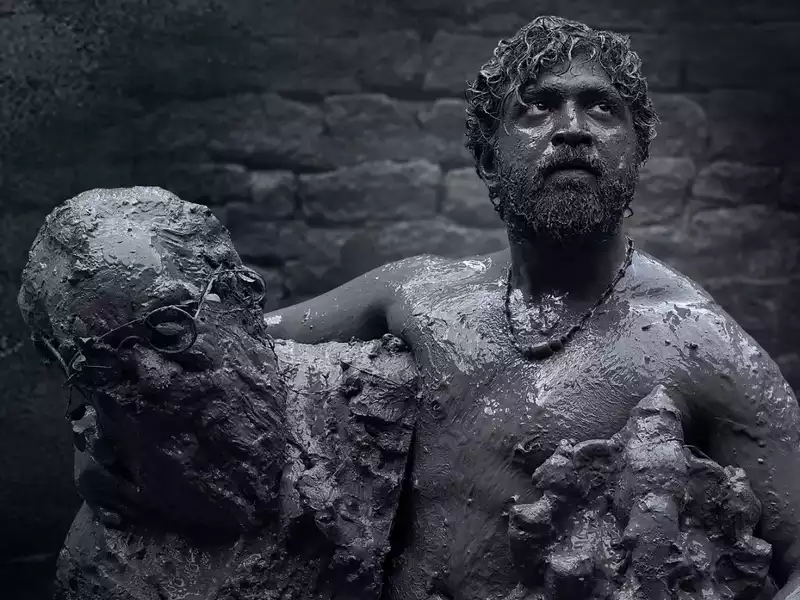The film has interesting characters and plot points. But they don’t come together as well as you’d hope. The rest of this review contains spoilers.
The opening shot of Vanangaan has a man bringing out a statue of Lord Ganesha that has fallen into a well. He has “saved” God, in other words. The closing shot of Vanangaan is a mirror image. It has the same man, the same well – but this time he is bringing out something else. I cannot reveal what this is, but we get a hint early in the movie, in GV Prakash Kumar’s beautiful song, Irai nooru. Lyricist Karthik Netha writes: “Kadavulai kaapaatra manidhan undu, manithanai kaapatra kadavul undo?” There’s always a man to save God, but is there a God to save man? My translation is clumsy, but this is the film’s existential crux, and in a way, you can say that this has been the existential crux of every Bala movie.
The last “Bala movie” was Naachiyaar in 2018. (Somehow, in my book, Varmaa doesn’t count.) The seven years in between have given some much-needed distance from this creator’s work, and even though the beats of Vanangaan are familiar, I enjoyed the world-building in the first half, with the typically offbeat “Bala characters”. The writing follows a clean, classical structure. The God concept is introduced first. (Along with Ganesha, there’s also a church.) Then we meet the protagonist Koti, played by a convincing Arun Vijay. We see the playful and deep bond between Koti and his sister Devi (an excellent Ridha). And then we discover that Koti cannot hear and speak, and that he can be a powerful savage when he sees injustice, like Vikram in Pithamagan. Then we meet Koti’s love interest, Tina, played by Roshni Prakash. And so forth.

With the exception of Devi, the characters have those wonderful quirks that only Bala can think of. Tina speaks multiple languages, and her mother wants her to open a restaurant in London. There’s a priest who lends himself to a very funny Sivaji Ganesan joke. There are some issues in the first half. Cinematically speaking, this is one of Bala’s weaker works. The film is crude, with apparently no concept of staging. Many scenes give the feel that they were shot in a hurry. The junior artists (many of them foreigners) are awful. Then there’s the suggestion that Tina likes getting beaten up by Koti, almost in a kinky way. Look, I’m the last person to judge other people’s BDSM fantasies, and I get that Koti is gender-neutral when it comes to bashing up people who annoy him. But the violence here feels sadistic and strange, like an affectation rather than something that truly reflects someone’s character.
The entire first half is a buildup to the interval, where Koti commits a crime. This involves molesters. Their deeds are captured through a camera that shows us their point of view, and this is a deeply squirm-making stretch. On the one hand, this POV shows us how girls that we view as people are reduced to mere bodies – naked bodies – by molesters. On the other hand, there’s the question of how much (and how many) of these naked bodies do we really need to see in order to get this point. Also, Koti has a brutal fight sequence with a bunch of men who harass some trans-women. Then he has a brutal fight sequence with the people who run a bar. So by the time we get to the third brutal fight at interval point, the point where we should really feel the brutality of the fight, the shock effects wear off, and it seems like more of the same.
With all this, the first half is still not bad. At interval point, we sit with the question of where the second half is going to go. And this is where Bala is unable to decide whether to go inward or outward. Going outward implies finding yet another criminal, yet another brutal fight, the scenes with a judge (sharply played by Mysskin), and melodrama between Koti and his sister. Samuthirakani has a lovely role as a cop who employs rough tactics but who also thinks with his heart. On the other hand, going inward is the only way to do justice to the premise, which appears derived from a Kannadasan classic. A doctor here quotes: “Ullam enbadhu aamai, adhil unmai enbadhu oomai”. The heart is like a tortoise, whose shell is snapped shut, tightly holding the silent truths inside. Koti won’t open up to anyone about his crime, because if he did, then other differently abled people will be affected. He understands their plight better than anyone else.
You can convert an existential question into a song, but how do you convert it into a mainstream movie? This is where, for all its strengths, Vanangaan suffers. Bala does some really interesting things. For instance, when a violent man has a sister, you think she will be the one who is molested – but her sufferings are of a different kind. We all know by now that Bala loves to shock us and make us weep, but in his best works, these feelings of shock and sorrow are earned. In Vanangaan, the many bits don’t come together satisfyingly, and the Big Existential Question at the centre around Koti’s silence doesn’t weigh on you like it should. Even at two hours, the film seems stretched. But it does give you something to think about, and these days, I guess, that itself is some kind of success.


